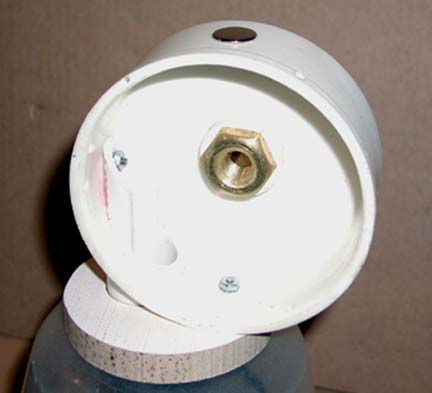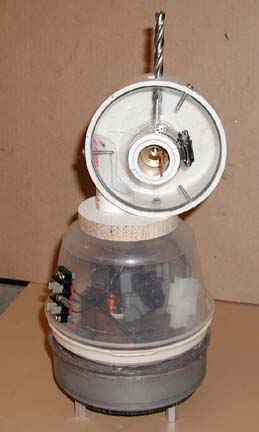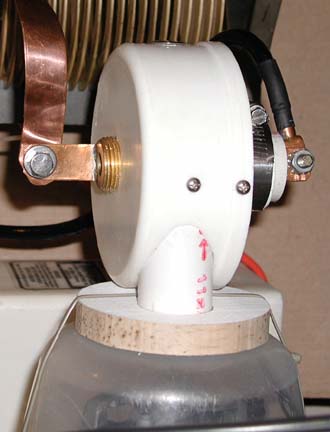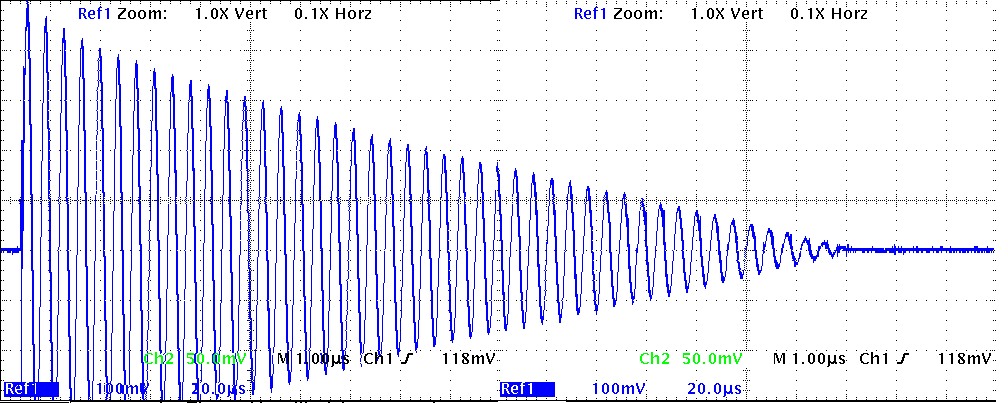
I've always been pleased with the results I've obtained from my single static vacuum gap. I believe the reduced gap losses as compared with a multiple static gap more than offset the inferior quenching that single gaps have. In my quest to better my coils performance even further, I wanted to build a gap that has the air pressure surrounding the gap higher than ambient atmospheric pressure, rather than less, as is the case in my vacuum gap. The thinking is that in higher-pressure gasses, the breakdown voltage is higher for the same gap setting, so for the same breakdown voltage, the gap would be narrower, and probably exhibit lower arc resistance and losses.
I again started with a vacuum cleaner motor, but this time used it to pressurize a Rubbermaid food storage container, and piped this into a 4" PVC pipe endcap for the gap enclosure. I had the air from the blower enter the enclosure tangentially, so that it spirals around the circumference, inward, to the gap electrodes. For the electrodes, I used the same kind of brass plumbing reducers that I used in my other vacuum gap, but this time had a machinist-friend put a smooth radius on the inside and outside edges of the arcing surface on a lathe. The air flow spirals inward towards the electrodes and the air is flowing in a circular pattern just before it exits through the reducers - a vortex. And so is born - The Vortex Gap.


Above shows the completed gap assembly, minus the electrical tape and cable tie necessary to keep the Rubbermaid container from popping open under pressure. A removable plug on the top of the PVC cap allows a drill bit to be inserted between the gap electrodes to set the gap spacing. The electrode nearest the camera is mounted on a piece of PVC pipe that can slide in and out of another pipe that is cemented to the clear Lexan disk that covers the end cap. The fixed pipe is slit with a hacksaw so that a hose clamp can lock the position of the inner pipe.

Above shows my gap wired into my coil. Behind it is a tuning coil I'm still fooling around with.
With my single vacuum gap, I used a gap spacing of 0.34". My very limited run time with this vortex gap had a slightly narrower gap spacing of 0.31". Judging by the vortex gap's tendency to generate racing sparks, I'm concluding that the gap is breaking down at a higher voltage, delivering a bigger bang than the vacuum gap did, despite the narrower gap. I'm going to attempt to quantify the gap losses as an equivalent gap-resistance by using my fiber probes, as time permits. Stay tuned.
OK, I did the measurements:
Today I found some time and performed a comparison between the gap losses of my single vacuum gap, and my new single vortex gap. To do so, I scoped the primary ringdown with no secondary in place. I used a Terry Fritz fiber optic voltage probe across the primary coil and a digital storage scope to record the results. I have not yet accurately calibrated the voltage readout, so for now, the results are just relative to each other.
With no secondary in place, the ringdown is a linearly decrementing waveform, not logarithmic. As such, the slope of the ringdown indicates the losses in the circuit and is independent of the gap firing voltage. I performed ringdown slope measurements at a variety of gap widths to vary the initial voltage, but the ringdown slope is a constant, independent of Vgap.
The power to the blower motor is varied through a lamp dimmer and I tried varying the motor speed to see what effect that had. At very low speeds, the linearly decrementing waveform became slightly logarithmic-looking, but still predominantly linear. Any speed above a very slow speed made no difference. The gap breakdown voltage appeared to change slightly at low speed, but this was hard to measure as it was slight and the bang-to-bang gap breakdown voltage is not as consistent as one might hope.
The slope decrement figures are assuming that my probe is accurately calibrated for voltage, though I suspect it may not be, so the figures are useful only for relative comparison purposes.
The pressurized vortex gap decremented at 200V/usec.
The vacuum gap decremented at 235V/usec (17.5% faster).
The vortex gap breakdown voltage is about 20% higher than the vacuum gap at the same gap distance.
I think the 17.5% reduction in gap losses makes this a very worthwhile design! Now if only I could find some tungsten pipe reducers…
Below is a two-part picture of a trace of the scope. The ramp rate is just slightly steeper in the beginning, then settles down to a uniform decrement all the way to zero:

The tank frequency is 138 KHz.